Spearfishing for lobster is more than just a dive—it’s a thrilling challenge that gets your adrenaline pumping. Picture this: you’re exploring the ocean’s depths, the water is crystal clear, and you spot a lobster tucked away in a rocky crevice. The excitement builds as you carefully plan your approach, knowing that this catch won’t be easy. Lobsters are fast, clever, and always ready to retreat at the slightest hint of danger, making every encounter a true test of patience and skill.
Lobsters are highly prized, not just for their rich, tender meat, but also because they’re tough to catch. They’re quick, they hide well, and they know how to put up a fight, which makes landing one feel like a major accomplishment. For many, there’s nothing quite as satisfying as surfacing with a lobster in hand, knowing you’ve earned it. It’s not just about filling your catch bag—it’s about the thrill of the chase, the rush of underwater exploration, and the reward of a successful hunt.
But here’s the thing: spearfishing for lobster isn’t something you can just dive into without preparation. You need the right techniques, the right gear, and a good understanding of lobster behavior to catch them safely and responsibly. It’s not just about grabbing the lobster—it’s about doing so in a way that protects you, the lobster, and the marine environment. Proper techniques will increase your chances of success and help you avoid any unnecessary harm to yourself or the ecosystem.
This guide is here to walk you through everything you need to know to spearfish for lobster like a pro. From learning their habits to mastering the tools of the trade, you’ll be ready to dive in with confidence. Whether you’re just starting or looking to level up your spearfishing game, this guide will help you turn your underwater adventure into an unforgettable—and rewarding—experience.
Understanding Lobster Behavior
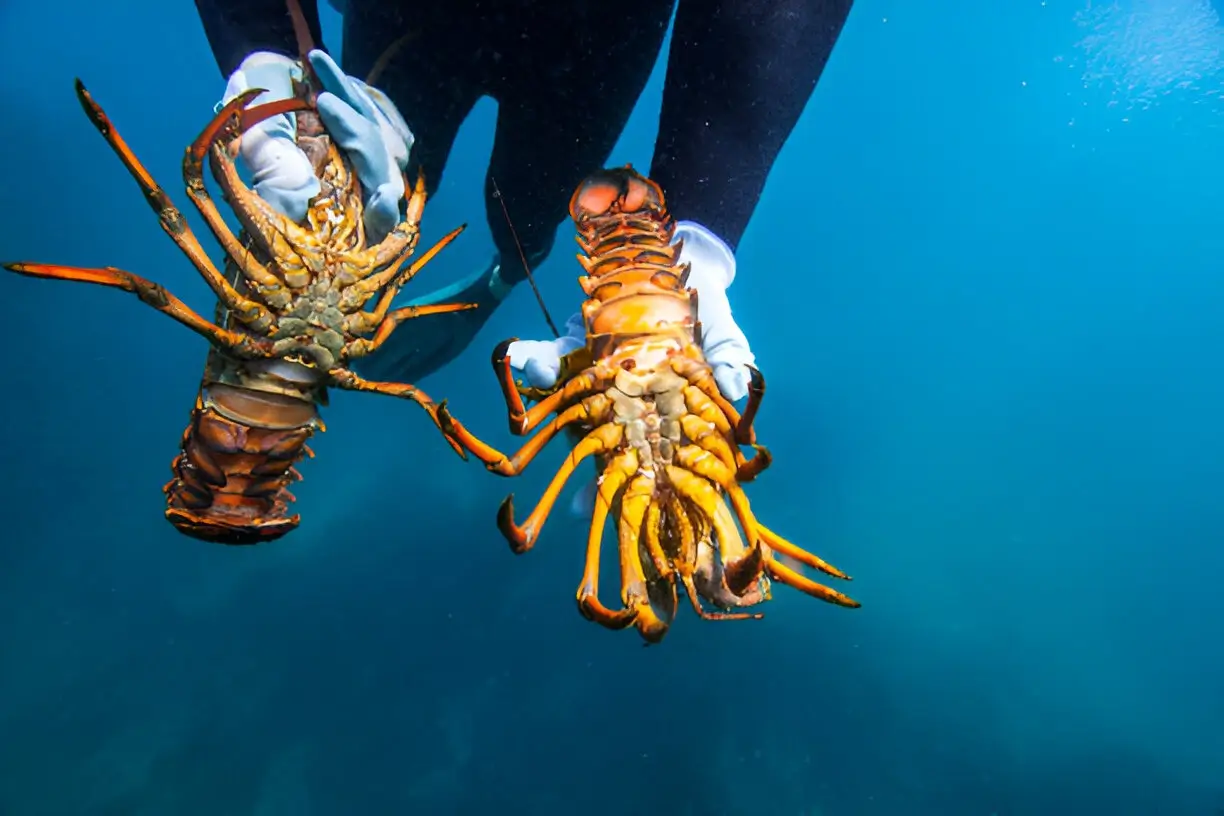
To catch lobsters like a pro, you need to understand their habits and how they move underwater. Lobsters are nocturnal creatures, meaning they’re most active at night. During the day, they tend to hide in crevices, under rocks, and within coral reefs to avoid predators. This makes them harder to spot during daylight dives, but not impossible—if you know where to look.
When lobsters move, they use their powerful tails to propel themselves backward quickly. This rapid, darting movement is their main defense mechanism, so if they feel threatened, they’ll retreat fast. It’s important to approach lobsters slowly and calmly to avoid spooking them.
Best Times of Day and Seasons for Spearfishing Lobsters
While lobsters can be caught during the day, they are far more active and easier to find at night. Night dives can be highly rewarding, as lobsters tend to leave their hiding spots to scavenge for food. Many experienced spearfishers prefer dusk or after dark, when lobsters are out in the open and less likely to bolt.
Seasonally, the best time to spearfish for lobsters depends on local regulations and breeding cycles. In most areas, lobsters have specific seasons to ensure their populations are protected. Researching local seasons and regulations before diving is crucial for responsible and legal spearfishing.
Where to Find Lobsters
Lobsters thrive in rocky environments, especially areas with plenty of hiding spots. Reefs, rock piles, and ledges are prime locations to find them. Look for lobsters tucked into cracks or crevices during the day or crawling out in the open at night. They often inhabit shallow waters near shorelines, though larger lobsters can be found in deeper areas. Finding their antennae poking out from a hole or their tail sticking out of a rocky crevice is a good sign you’re in the right spot.
Essential Gear for Lobster Spearfishing
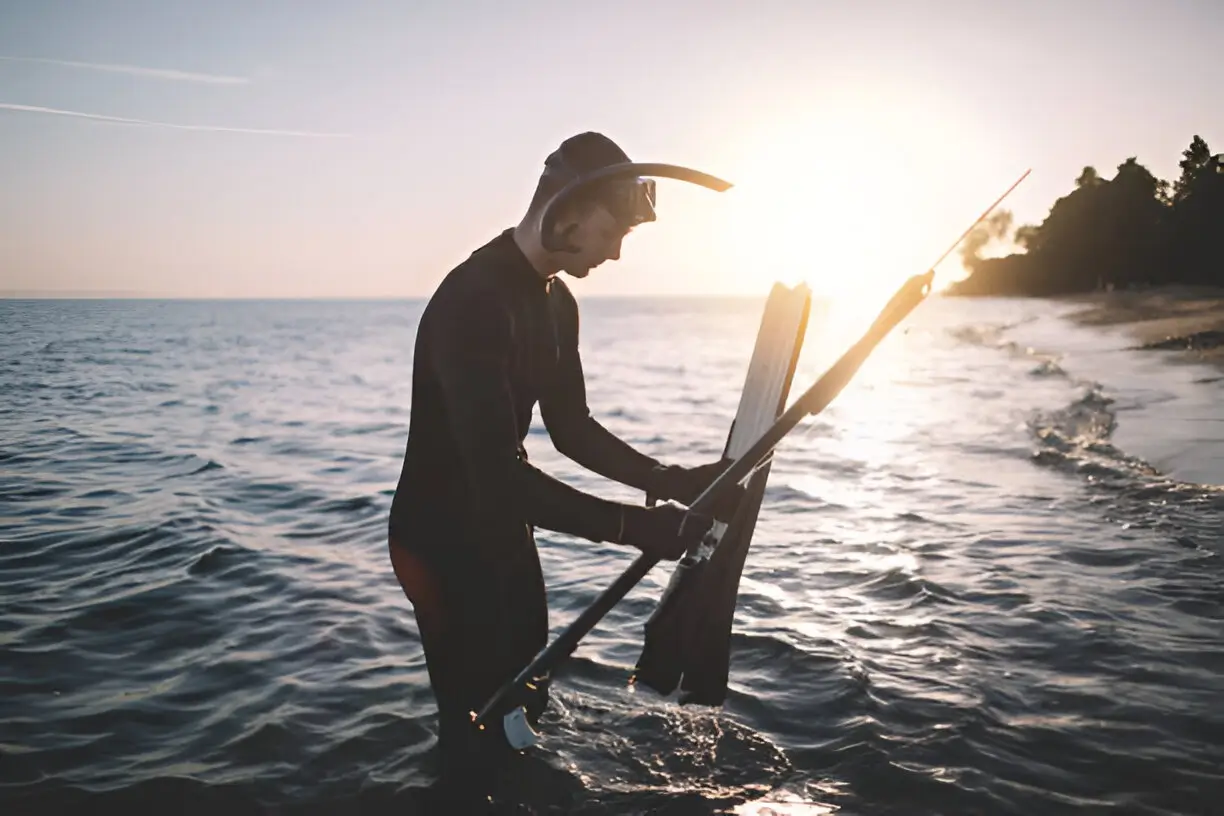
Having the right gear is crucial for a successful and safe lobster spearfishing experience. Whether you’re new to the sport or looking to upgrade your equipment, using the right tools makes all the difference in comfort, safety, and success. Below are some gear essentials, with links to trusted gear you can buy for your next adventure.
Spearfishing Gear: Wetsuits, Fins, Spears, and Gloves
- Wetsuits: A good wetsuit keeps you warm and protected while diving. Lobsters like to hide in rocky crevices, so having a durable suit that can withstand bumps against sharp surfaces is important. Thicker wetsuits are great for colder waters, while thinner ones work well in tropical environments. Check out these top-rated wetsuits for every water condition.
- Fins: A good pair of fins helps you move efficiently through the water, saving energy during long dives. You’ll need to be agile and swift, especially when chasing down lobsters that try to escape into hard-to-reach spots. Browse the best fins for spearfishing that offer comfort and power.
- Spears: Though spearguns are essential for traditional spearfishing, lobsters aren’t typically caught with spears. However, some divers like to have one handy for other fish they may encounter along the way. Explore reliable spearguns for multi-purpose dives.
- Gloves: Lobsters have sharp spines and can easily cause injury if you’re not careful. A pair of thick gloves provides protection when handling lobsters, reaching into rocky crevices, or dealing with their powerful claws. Get durable gloves for underwater protection.
Lobster-Specific Tools: Tickle Sticks, Snares, and Lobster Bags
- Tickle Sticks: A tickle stick is a slender rod used to gently coax lobsters out of their hiding places without harming them. By tapping or nudging them, you can move them into an open area, making them easier to catch. Find the best tickle sticks for lobster hunting.
- Snares: Lobster snares are designed to safely loop around the lobster’s tail, allowing you to catch it without causing injury. Once you’ve lured a lobster out, you can slip the snare over its tail and secure your catch. Check out these lobster snares to add to your gear kit.
- Lobster Bags: A lobster bag is an essential tool for storing your catch while you continue your dive. These bags are designed with mesh or slotted openings, so water flows through, but lobsters stay safely inside. A secure and easy-to-carry bag helps you focus on the dive without worrying about losing your catch. Discover top-rated lobster bags for a safe and secure catch.
Why Proper Equipment Can Make or Break Your Dive
Having the right gear doesn’t just improve your chances of success—it also ensures your safety and comfort. Diving in unpredictable environments requires equipment that helps you stay agile and efficient. The right gear allows you to navigate tricky underwater terrain, protect yourself from sharp rocks, and handle lobsters without injury. Additionally, using lobster-specific tools, like tickle sticks and snares, ensures you can catch lobsters humanely and without causing harm to the marine enviro
Spearfishing Techniques for Catching Lobster
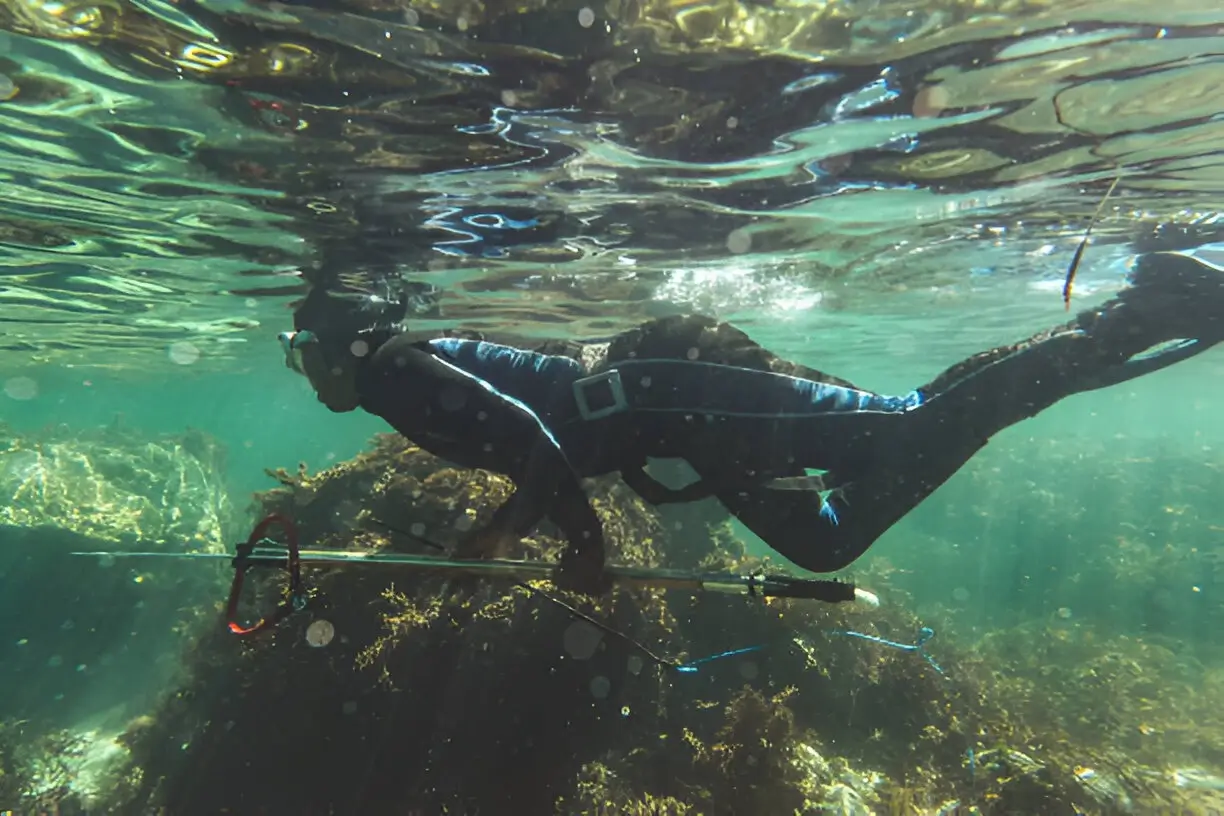
Catching lobsters while spearfishing requires both patience and strategy. With their sharp senses and quick reflexes, lobsters can be tricky to catch. But by using the right techniques and tools, you can significantly increase your chances of success. Here are some essential tips for approaching and catching lobsters safely and effectively.
How to Approach Lobsters Without Scaring Them Away
Lobsters are highly sensitive to movement and vibration, making it crucial to approach them slowly and cautiously. Here are a few tips:
- Stay low: When you spot a lobster, try to stay close to the seafloor. This reduces your silhouette and helps you move less conspicuously.
- Slow and steady movements: Sudden, jerky movements can easily spook a lobster. Keep your movements slow and smooth as you approach them.
- Maintain distance: Avoid getting too close too quickly. Lobsters can dart backward at high speeds, making them difficult to catch once they sense danger. Maintain a slow, steady approach to avoid alarming them.
Use a Tickle Stick or Snare for Safe and Effective Capture
Once you’ve positioned yourself near the lobster, the right tool can make all the difference. Here’s how you can use a tickle stick or lobster snare for a humane and efficient catch:
- Tickle Stick: This is a slender rod used to gently coax the lobster out of its hiding spot. Lobsters typically hide in rocky crevices, so you can use the stick to nudge them out slowly. Be patient and avoid applying pressure. Get the best tickle sticks for easy lobster hunting.
- Lobster Snare: A snare is designed to loop around the lobster’s tail without harming it. Once you’ve guided the lobster out using the tickle stick, you can quickly slip the snare around its tail and secure your catch. Find high-quality lobster snares here to make your capture effortless and safe.
Step-by-Step Guide on How to Corner and Catch Lobsters in Their Hiding Spots
Here’s a quick step-by-step guide to help you land your lobster catch:
- Spot your target: Look for lobsters hiding under rocks, in crevices, or along reefs. Lobsters are most active at night, but they can still be found in the day if you know where to look.
- Approach slowly: As mentioned earlier, move in slowly and stay low to avoid spooking the lobster.
- Use the tickle stick: Gently use the tickle stick to nudge the lobster out of its hiding spot. Be patient—lobsters will often resist at first but will eventually move out.
- Position the snare: Once the lobster is out in the open, place the snare carefully around its tail. Ensure the loop is positioned correctly for a quick, secure catch.
- Secure your catch: Tighten the snare and transfer the lobster into your lobster bag for safekeeping. Check out the best lobster bags here for an easy-to-carry, secure solution.
Best Locations for Spearfishing Lobster
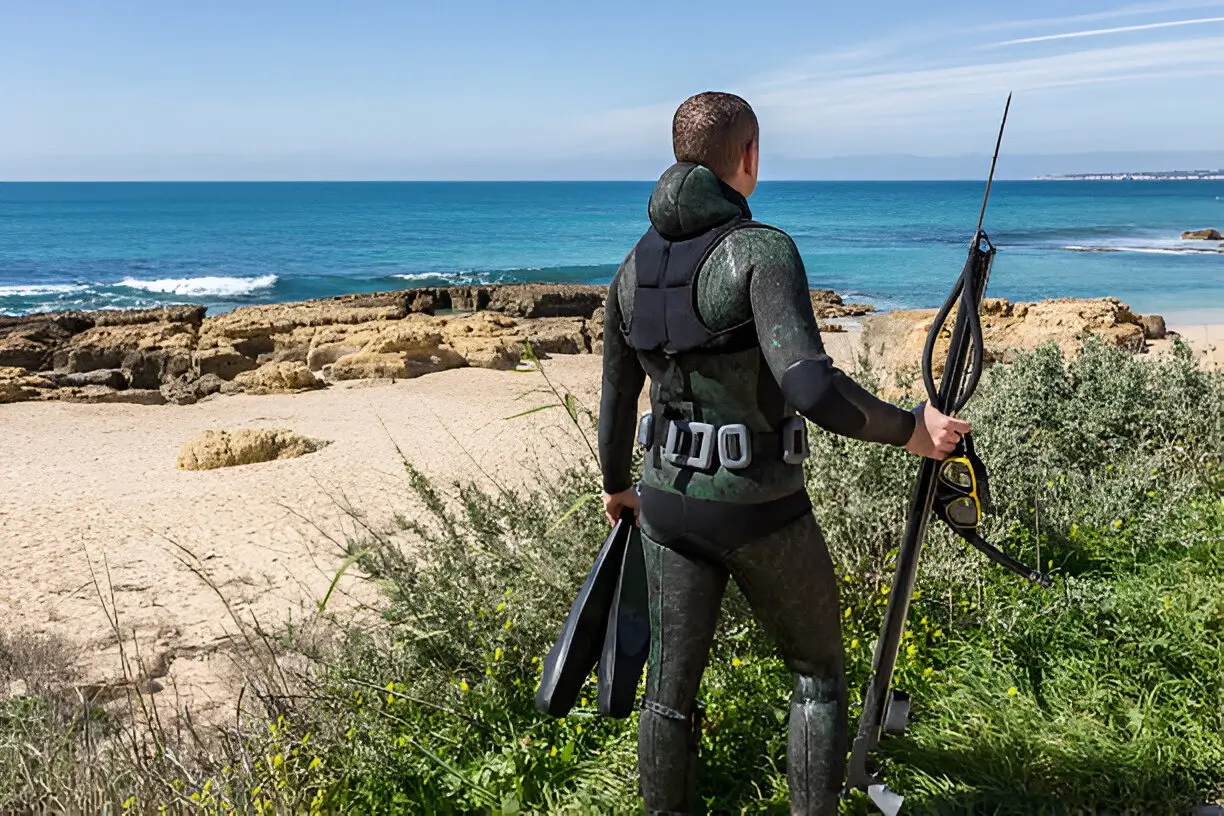
Spearfishing for lobster is an exciting challenge, and some of the best locations around the world provide prime conditions for landing these prized catches. Below are top spearfishing spots for lobsters, along with environmental tips to help you scout for the best areas.
Top Spearfishing Locations for Lobster Around the World
Florida Keys, USA
The warm waters and abundant reefs of the Florida Keys make it one of the premier spots for lobster spearfishing. The annual Florida lobster mini-season attracts divers from all over the world, offering a chance to catch spiny lobsters in the shallow and deep waters around the islands. Find top-rated Florida spearfishing tours and gear.
California, USA
California’s coastal waters are home to the California spiny lobster. Popular spots include Catalina Island and San Diego, where rocky reefs and kelp forests offer excellent lobster hunting opportunities. Lobster season typically runs from October to March. Explore spearfishing charters and gear in California.
The Mediterranean Sea
The Mediterranean offers crystal-clear waters and diverse marine life, including the European spiny lobster. Popular lobster spots include areas around Italy, Greece, and the Spanish coast, where lobsters thrive among rocky sea beds and underwater caves. Book a Mediterranean spearfishing experience for your next adventure.
Bahamas
Known for its pristine waters and abundant marine life, the Bahamas is a top destination for lobster spearfishing. The archipelago’s coral reefs provide ideal hiding spots for lobsters, especially around Nassau and the Exumas. Check out spearfishing trips and lodges in the Bahamas.
Australia (Great Barrier Reef)
The Great Barrier Reef in Australia is one of the best places in the world for spearfishing. The spiny lobster found here is a favorite for many divers, and the vast reef systems provide plenty of areas to explore. Discover guided spearfishing tours on the Great Barrier Reef.
Mexico (Baja California Peninsula)
Baja California is another hotspot for lobster spearfishing, especially during the fall season. The region’s reefs and underwater caves are full of lobsters, making it a prime spot for adventurous spearfishers. Browse spearfishing packages in Baja California.
Hawaii, USA
Hawaii’s unique marine ecosystems make it an excellent destination for spearfishing lobsters, particularly around Oahu and Maui. The rocky underwater terrain and warm tropical waters are perfect habitats for the slipper and spiny lobster species found in the area. Explore Hawaiian spearfishing charters.
Key Environmental Factors to Look for When Scouting for Lobsters
When hunting lobsters, understanding their environment is key. Here are some important factors to consider when choosing your next location:
- Rocky Reefs and Crevices: Lobsters love to hide in cracks and crevices, so scouting areas with plenty of rocks, coral reefs, and underwater caves will increase your chances of finding them.
- Water Temperature: Lobsters thrive in temperate to warm waters, usually between 50°F and 80°F (10°C to 27°C), depending on the species. Make sure you choose locations where water temperatures are favorable for lobster habitats.
- Tides and Currents: Lobsters tend to be more active during changing tides and prefer locations with moderate currents. Pay attention to tide schedules and choose times when water movement will stir up activity.
- Night Diving: Lobsters are nocturnal, meaning they are most active at night. Many experienced spearfishers recommend diving during the evening or early morning hours to catch lobsters when they are out foraging. Get the best night diving gear here.
Laws and Regulations for Lobster Spearfishing
Before you embark on your lobster spearfishing adventure, it’s crucial to understand the laws and regulations that govern the practice in your chosen location. These rules are designed to promote sustainability, protect marine ecosystems, and ensure the safety of divers. Here’s a comprehensive guide to the key aspects of lobster spearfishing regulations.
Importance of Knowing Local Regulations
Local regulations often differ greatly from region to region. Familiarizing yourself with these rules not only helps you stay legal but also contributes to the long-term health of lobster populations and their habitats. Make it a priority to research the specific regulations for the region where you plan to dive. Visit this site for detailed information on local lobster regulations.
Legal Limits on Catch Sizes
Most locations have specific laws regarding the size and number of lobsters you can catch. These regulations are intended to ensure that juvenile lobsters have a chance to mature and reproduce before being harvested. Here are some frequently observed rules you could encounter:
- Minimum Size Limits: Many areas enforce a minimum size requirement for lobsters, often measured from the carapace. Ensure you have a measuring device on hand to confirm your catch meets legal size requirements. Find lobster measuring tools here.
- Bag Limits: Most jurisdictions impose limits on the number of lobsters you can catch in a single day. These limits can vary by location, so it’s essential to check the regulations for your diving area.
Seasonal Restrictions
Lobster populations need time to regenerate, which is why many locations enforce seasonal closures during breeding periods. These restrictions help maintain healthy lobster stocks and support sustainable fishing practices. Be aware of:
Closed Seasons: Some regions may have specific months or seasons when lobster harvesting is prohibited. Check with local wildlife authorities or fishing organizations for accurate seasonal dates. Explore this resource for seasonal regulations.
Licensing Requirements
In many areas, you’ll need a fishing or spearfishing license to legally catch lobsters. Licensing requirements can vary based on factors like residency and the type of fishing you plan to do. Make sure to:
Obtain the Proper License: Research and obtain any necessary licenses before your diving trip. Many local authorities offer online applications for fishing licenses. Purchase your fishing license here.
Ethical Spearfishing: Sustainability and Respecting Marine Ecosystems
Practicing ethical spearfishing is crucial for maintaining the balance of marine ecosystems. Here are some key principles to follow:
- Practice Selective Harvesting: Focus on taking only mature lobsters and avoid catching females carrying eggs (berried females). This helps protect the breeding population.
- Minimize Environmental Impact: Be mindful of your surroundings while diving. Avoid damaging coral reefs and other habitats, and refrain from disturbing marine life unnecessarily.
- Participate in Conservation Efforts: Many organizations work to protect marine ecosystems. Consider participating in local clean-up events or supporting conservation initiatives. Join local marine conservation groups here to get involved.
Safety Tips for Lobster Spearfishing
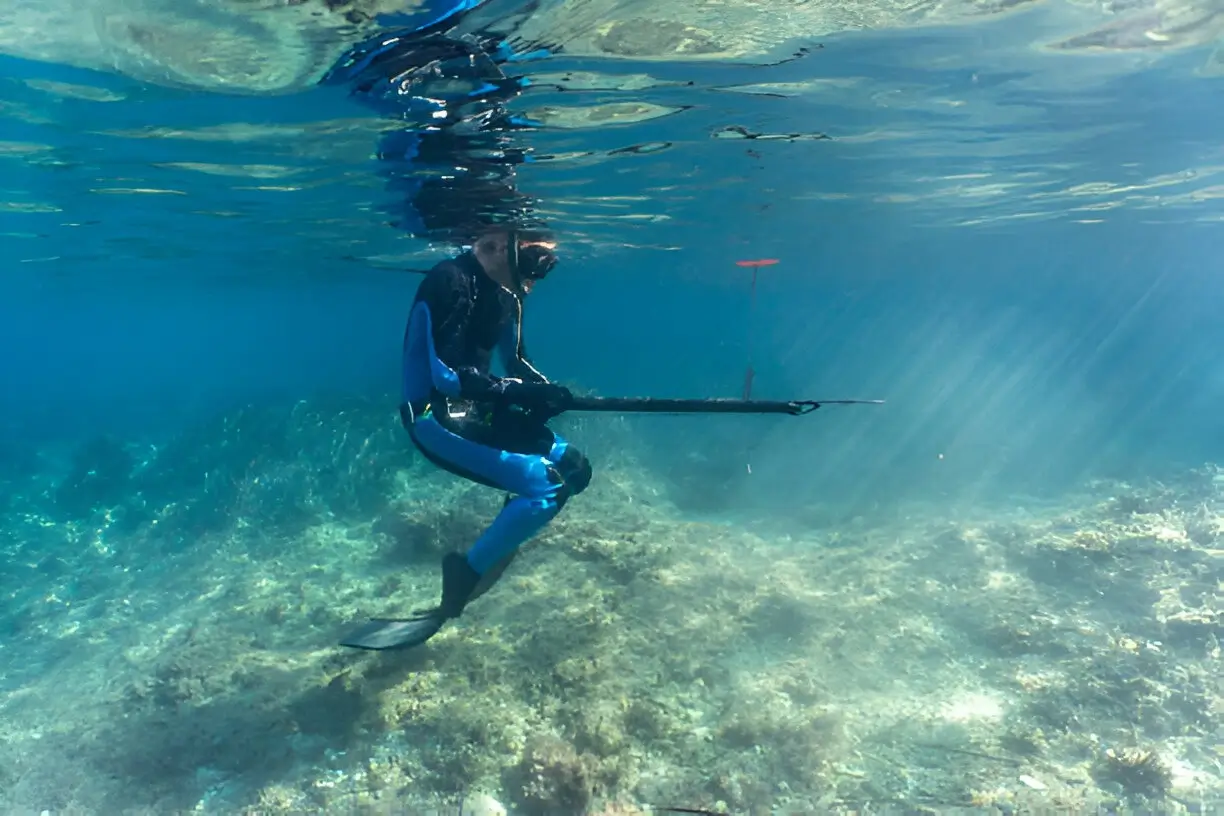
Spearfishing for lobster can be an exhilarating experience, but safety should always be your top priority. Here are some essential safety tips to keep in mind before and during your dive, ensuring a fun and secure adventure beneath the waves.
Importance of Buddy Diving
Diving with a buddy is one of the most critical safety practices in spearfishing. Here’s why:
- Increased Safety: Having a partner means someone is always watching your back. If an emergency arises—like equipment failure or getting lost—your buddy can assist you quickly.
- Enhanced Awareness: A dive buddy can help keep you aware of your surroundings, watching for any potential dangers such as strong currents or marine life.
- Shared Experience: Lobster spearfishing is more enjoyable with a companion. You can share tips, celebrate catches, and even assist each other during the dive.
Tip: Always establish a communication plan with your buddy before diving, including hand signals for essential messages. Learn more about safe diving practices here.
Handling Sharp Objects (Spears, Snares) Underwater
When spearfishing, you’ll be handling sharp tools like spears and snares. To ensure safety:
- Proper Grip: Always maintain a firm grip on your spear or snare. Use the correct hand position to prevent accidental slips that could lead to injuries.
- Awareness of Surroundings: Be mindful of where your spear is pointing at all times. Avoid swinging your spear around or using it recklessly, especially near your buddy or delicate marine life.
- Secure Tools: When not in use, make sure your spear and snare are secured in a safe position. Consider using a spear holder or keeping them attached to your diving gear.
Tip: Invest in high-quality spearfishing gear to minimize the risk of accidents. Find top-rated spears and snares here.
How to Handle a Lobster Safely After the Catch
Once you’ve caught your lobster, it’s essential to handle it properly to avoid injury and ensure its freshness:
- Use Gloves: Always wear gloves when handling lobsters. Their claws can be sharp and may pinch you, which can be painful.
- Secure the Lobster: After catching the lobster, hold it securely to prevent it from escaping. You can use a lobster bag to keep it safe while you continue to dive.
- Be Mindful of Spines: Some lobster species have sharp spines. Handle them gently to avoid cuts or injuries.
- Keep It Fresh: If you plan to keep the lobster, store it in a cool, damp environment until you can properly clean and prepare it. This will help maintain its freshness.
Common Mistakes and How to Avoid Them
Spearfishing for lobster is thrilling, but it’s easy to make mistakes that can cost you the catch or even put you in danger. Here are some common pitfalls to watch out for and tips on how to avoid them.
Rushing the Catch and Scaring Lobsters Away
One of the biggest mistakes spearfishers make is rushing in to catch a lobster without proper technique. Quick movements can startle lobsters, sending them scuttling into their hiding spots.
How to Avoid This Mistake:
- Approach Slowly: When you spot a lobster, take your time and approach slowly. Moving deliberately will help you get closer without alarming them.
- Observe Before Acting: Take a moment to watch the lobster’s behavior. This can give you clues about where it might hide or how to approach it more effectively.
- Practice Patience: Remember, patience is key. Sometimes waiting a moment can lead to a better opportunity to catch your lobster.
Tip: Consider practicing your stealthy approach in shallow waters to build confidence.
Not Properly Securing the Lobster After Catching It
Once you’ve successfully caught a lobster, failing to secure it properly can lead to losing your catch or injuring yourself in the process.
How to Avoid This Mistake:
- Use a Lobster Bag: Invest in a good-quality lobster bag designed to keep your catch secure while allowing water to flow through. Check out our top lobster bags here.
- Keep It Close: Hold the lobster securely with one hand while you maneuver your spear or snare with the other. Be mindful of your grip to prevent any slips.
- Stay Calm: If the lobster starts to wiggle or escape, try to stay calm and re-secure it rather than panicking.
Tip: Practice securing your catch in a controlled environment before diving.
Navigating Tough Underwater Terrain
Lobsters often hide in rocky crevices, coral reefs, or caves, which can pose challenges when navigating underwater. Improper navigation can lead to injuries or even getting stuck.
How to Avoid This Mistake:
- Familiarize Yourself with the Area: Before diving, do some research or explore the area while snorkeling. Understanding the layout can help you navigate more safely.
- Use a Dive Knife: Always carry a dive knife in case you need to cut yourself free from entanglements or tackle any unexpected situations. Explore our recommended dive knives.
- Stay Aware of Your Surroundings: Keep an eye on your surroundings, particularly your depth and proximity to structures. Watch for sharp rocks or unstable terrain that could cause accidents.
Tip: Practice diving in different environments to improve your navigation skills. Join a local diving class for navigation techniques.
Post-Catch: What to Do After Landing Your Lobster
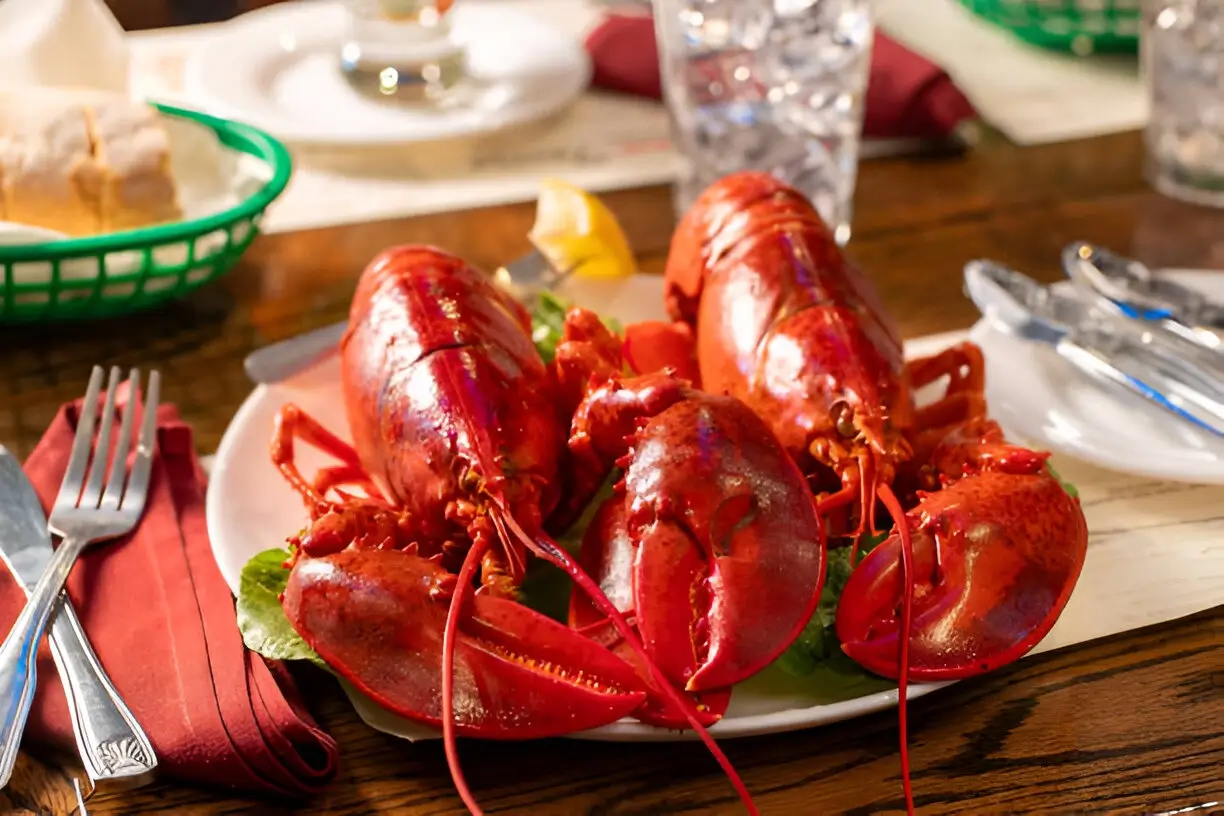
Landing a lobster is an exciting achievement, but the fun doesn’t end there! Properly handling, cleaning, and preparing your catch is essential for enjoying its delicious flavors. Here’s a guide on best practices for post-catch care and some tasty recipes to try.
Best Practices for Cleaning, Storing, and Preparing Lobsters
Cleaning Your Lobster
Proper cleaning is crucial for ensuring your lobster is safe to eat and tastes great. Here’s how to do it:
- Immediate Cleaning: Clean the lobster as soon as possible after catching it. This helps maintain its freshness and flavor.
- Rinse with Salt Water: Use seawater or a saltwater solution to rinse off any debris and impurities from the lobster’s shell. This keeps it tasting fresh.
- Remove the Stomach and Gills: Using a sharp knife, carefully remove the stomach and gills (the feathery parts located behind the eyes).
Storing Your Lobster
If you’re not cooking the lobster immediately, proper storage is key to preserving its quality:
Preparing Your Lobster for Cooking
Before cooking, you can prepare your lobster to enhance its flavor:
- Pre-Cook in Saltwater: Some chefs recommend blanching lobsters in boiling salted water for a couple of minutes to pre-cook them. This helps retain their natural sweetness.
- Split the Lobster: For grilling or steaming, split the lobster down the middle. This not only allows for even cooking but also enhances presentation.
Delicious Lobster Recipes and Cooking Techniques
Once your lobster is clean and ready, it’s time to cook! Here are some delicious recipes and cooking techniques to try:
Grilled Lobster Tails
- Ingredients: Lobster tails, butter, garlic, lemon juice, and herbs.
- Instructions:
- Preheat your grill to medium heat.
- Cut the lobster tails in half and brush with melted butter mixed with minced garlic and lemon juice.
- Grill for about 5-7 minutes until the meat is opaque and tender.
Serving Suggestion: Serve with a sprinkle of fresh herbs for added flavor.
Classic Lobster Roll
- Ingredients: Freshly cooked lobster meat, Creamy mayonnaise, Crisp celery, finely chopped, Zesty lemon juice, Soft, buttery hot dog buns.
- Instructions:
- Chop the cooked lobster meat and mix with mayonnaise, diced celery, and a splash of lemon juice.
- Toast the hot dog buns and fill them with the lobster mixture.
Serving Suggestion: Garnish with fresh chives or dill. Find the best kitchen tools for your lobster roll here.
Lobster Bisque
- Ingredients: Lobster shells, cream, onion, garlic, and herbs.
- Instructions:
- Sauté onions and garlic, then add lobster shells and cook until fragrant.
- Add water and simmer to create a stock. Strain and mix with cream and seasonings.
Serving Suggestion: Serve warm with a drizzle of olive oil. Check out our recommended cooking supplies here.
Becoming a pro at spearfishing for lobster is all about mastering key skills and respecting the ocean. Here’s a quick recap:
- Know Your Prey: Understand lobster habits and where to find them for better success.
- Gear Up: Equip yourself with quality spearfishing gear and tools.
- Perfect Your Technique: Approach lobsters calmly and use effective techniques to catch them.
- Stay Safe: Dive with a buddy, stay aware of your surroundings, and handle equipment carefully.
- Post-Catch Care: Clean and store your lobster properly, and enjoy trying out delicious recipes.
